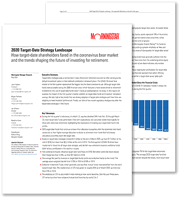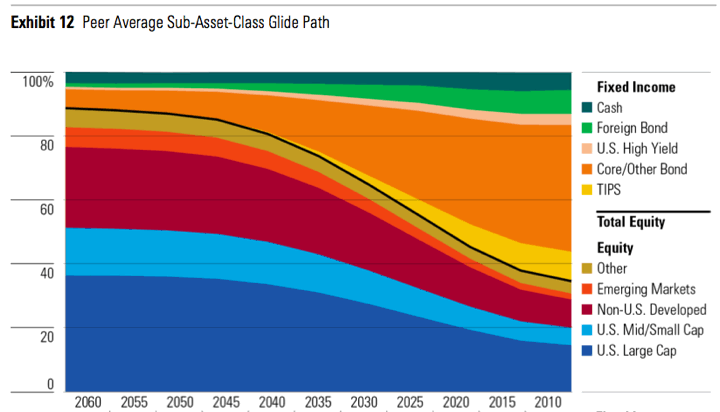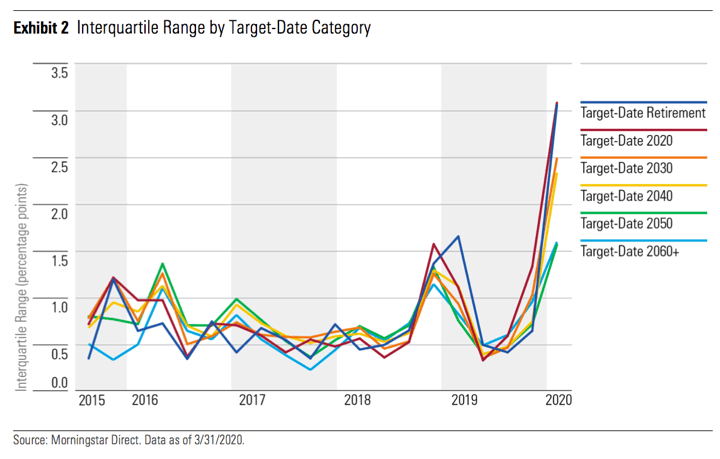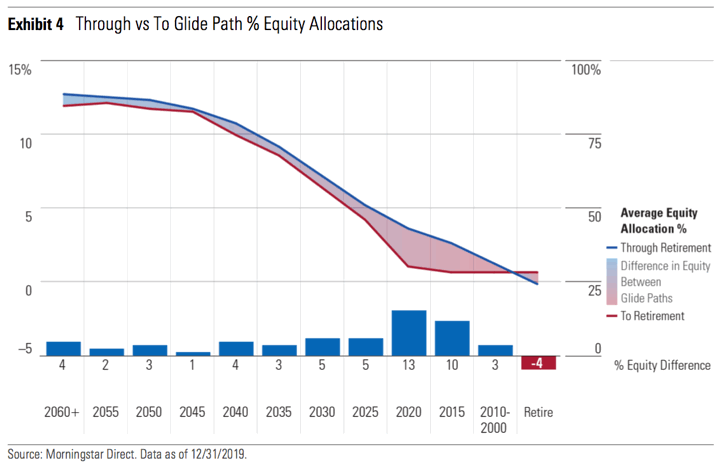
The default option inside many employer-sponsored retirement plans are Target Date Funds (TDFs), which adjust their portfolio holdings automatically over time based on a specific target retirement date. Morningstar just released their . You’ll need to provide your name and e-mail to download the . There is a lot of in-depth analysis for industry insiders, although many individual investors are basically stuck with the one fund series that is available in their 401k/403b plan. Besides looking up your fund, here are a few broader takeaways.
Here is the average glide path across 53 different TDF series (taken from 2019 report). On average, most TDFs have an asset allocation close to 90% equity and 10% bonds in the early years, with the equity percentage dropping (and bond percentage rising) as time goes on. At the year of retirement, the average asset allocation is roughly 45% equity and 55% bonds.

Glide paths stick closer to the average across funds during the early accumulation years, but differ much more as you near retirement. Near-retirees take notice! The chart below shows the historical percentage difference in quarterly return between funds with the same target dates. (All the 2020 funds were compared, all the 2030 funds were compared, etc.) You can see that during the “COVID crash” in Q1 2020, the biggest difference in performance actually came from the funds meant for those in retirement.

Some TDFs maintain a higher equity allocation and keep lowering it gradually “through” the retirement date, while others decrease more sharply right up “to” the retirement date and then hold things steady. For a 2020 fund, this could mean a 15% difference in the amount of stocks being held in 2020 (ex. 45% stocks vs. 30% stocks). The situation actually flips a decade after retirement and the “through” funds end up holding less stocks on average.

The past performance of TDFs often hinges on recent stock market performance and which funds are holding the most stocks (or most domestic stocks). Both the “through” and “to” methods have their pros and cons, but one might fit your own preferences better. I personally think that people do respond differently to market drops after they stop working completely and have fully exhausted their “human capital”. (Once you can’t make any more money, you start to stare at your balance more often…) Perhaps the gradual “through” funds would work better for those that also stop working gradually, while the “to” funds would be better for those that stop work completely.
You can adjust your volatility level by picking a different date. You probably only have one TDF series as opposed to a wide menu. If it’s too stock-heavy for you, then just pick a retirement date that is earlier. If it holds too many bonds, then just pick a retirement date that is earlier. There is no rule that you have to pick your actual retirement year, or even any single one.
Gold or Silver-rated Target Date Funds. Morningstar changed up their ratings methodology in November 2019. A very detailed explanation and full rankings are in the report. Here are the gold/silver-rated funds and whether they are “through/to”:
- Blackrock LifePath Index (To)
- JPMorgan SmartRetirement Blend (To)
- Fidelity Freedom Index (Through)
- Fidelity Freedom (Through)
- JPMorgan SmartRetirement (To)
- State Street Target Retirement (Through)
- Vanguard Target Retirement (Through)
- American Funds Target Date Retirement (Through)
- T. Rowe Price Retirement (Through)
All other things equal, I’d still prefer a passive index approach with rock-bottom costs, but I’m glad to see even the actively-managed TDFs have lower expense ratios now than before.
Some of these TDF series are not available to retail investors outside of a employer-sponsored retirement plan. The Vanguard Target Retirement fund series remains the most popular with a 37% market share as of March 2020, and is also available to retail investors with a $1,000 minimum investment.
Bottom line. Although we often don’t have much choice in the matter, the good news is that every year the average target date fund gets cheaper and more competitive. Any of the gold/silver fund series above are able to provide a simple all-in-one solution. Added together, these “top-rated” options make up 78% of all TDF assets. However, it is still important to understand how your fund’s asset allocation changes as it nears the target retirement year, and know that you can pick a different year to adjust your risk level. If your fund is one of the bottom-dwellers, you may want to use this report to bug the HR department.
“The editorial content here is not provided by any of the companies mentioned, and has not been reviewed, approved or otherwise endorsed by any of these entities. Opinions expressed here are the author’s alone. This email may contain links through which we are compensated when you click on or are approved for offers.”
from .
Copyright © 2019 MyMoneyBlog.com. All Rights Reserved. Do not re-syndicate without permission.